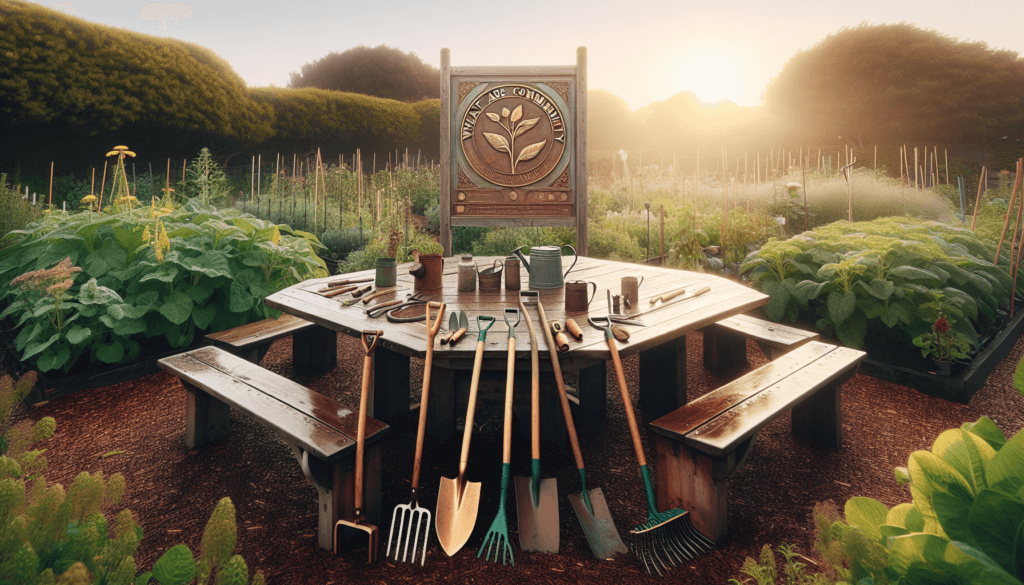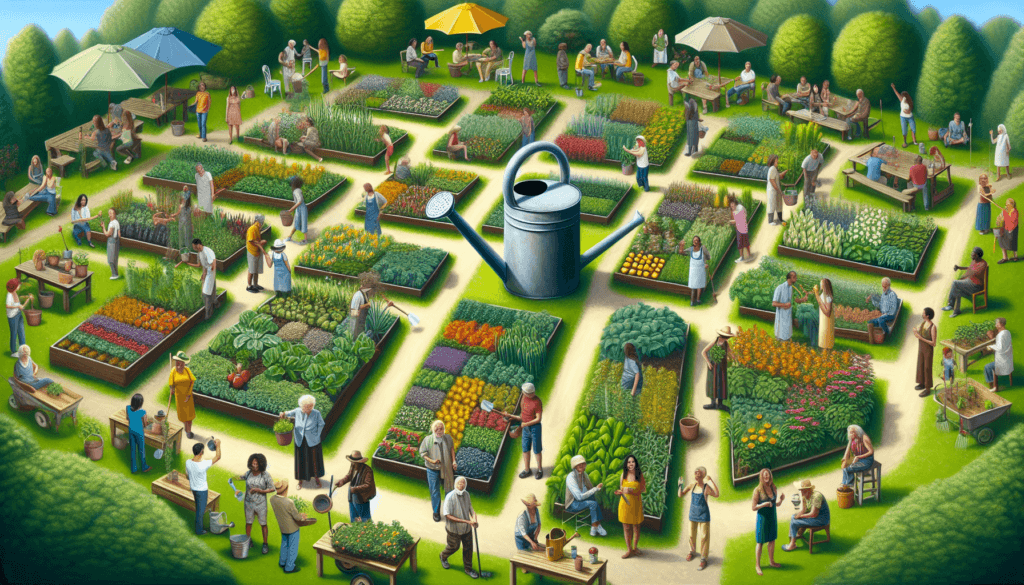Have you ever wondered what community gardens are called? These green spaces, tucked away in neighborhoods, hold a sense of unity and connection among community members. But what are they actually called? In this article, we will explore the various names that community gardens are known by around the world. From allotment gardens to urban farms, discover the different terms used to describe these vibrant and nurturing spaces where people come together to grow, learn, and cultivate a sense of belonging. Community gardens are often known by various names, depending on their purpose and location. Let’s explore the different types of community gardens and the common, traditional, international, and alternative names they go by. We’ll also delve into the gardening practices and concepts found within these green spaces, as well as the common features and benefits they offer.

Types of Community Gardens
Allotment Gardens
Allotment gardens are one of the most common types of community gardens. They are individual plots of land that are rented or leased by community members to grow their own fruits, vegetables, and flowers. Allotment gardens are often found in urban areas where space is limited, and they provide individuals with the opportunity to cultivate their own plants and have a sense of ownership over their plot.
Neighborhood Gardens
Neighborhood gardens are open to all residents within a particular community or neighborhood. These gardens serve as a hub for social interaction and community building, as people from all walks of life come together to grow and nurture plants. Neighborhood gardens can foster a sense of belonging and create a shared space for neighbors to connect with each other and nature.
School Gardens
School gardens are an excellent educational tool that engages students in hands-on learning about gardening, agriculture, and environmental sustainability. These gardens are typically found on school grounds and allow students to grow their own produce, learn about plant life cycles, and gain a deeper understanding of the importance of healthy eating habits. School gardens encourage a connection with nature and promote a sense of stewardship among young individuals.
Therapeutic Gardens
Therapeutic gardens are designed to promote healing, relaxation, and well-being. These gardens are often found in healthcare facilities, rehabilitation centers, or mental health institutions. The serene and beautiful surroundings of therapeutic gardens provide patients and visitors with a calming and peaceful environment, which can aid in their physical and mental rehabilitation.
Youth Gardens
Youth gardens are specifically designed to engage and empower young individuals in gardening activities. These gardens provide a space for children and teenagers to learn about nature, cultivate plants, and develop important life skills such as teamwork, responsibility, and patience. Youth gardens can be found in schools, community centers, or dedicated green spaces, and they aim to inspire a love for gardening and environmental conservation from an early age.
Common Names for Community Gardens
Urban Gardens
Urban gardens are community gardens located in urban areas or cities. These gardens are often established in vacant lots, rooftops, or other underutilized spaces within the city limits. Urban gardens bring nature into the concrete jungle and provide residents with a sanctuary to grow their own fresh produce, beautify their surroundings, and reconnect with the natural world.
City Gardens
City gardens are similar to urban gardens and are found within the boundaries of a city. These gardens may vary in size and design, ranging from small-scale pocket gardens to larger community green spaces. City gardens contribute to the overall aesthetics of the urban landscape while promoting sustainable living practices and fostering a sense of environmental responsibility.
Shared Gardens
Shared gardens, as their name suggests, are gardens that are shared among a group of individuals or a community. These gardens allow people to collectively tend to the plants and share in the harvests. Shared gardens create a sense of camaraderie and unity among gardeners, fostering social interaction and building strong community bonds.
Public Gardens
Public gardens are open to the public and are often maintained by local authorities or organizations. These gardens are meant to be enjoyed by everyone, providing a serene environment for relaxation, recreation, and appreciation of nature’s beauty. Public gardens may showcase a wide variety of plants, including ornamental flowers, unique tree species, or edible plants.
Kitchen Gardens
Kitchen gardens, also known as vegetable gardens or herb gardens, are designed to provide individuals with a source of fresh, homegrown produce for culinary purposes. These gardens are typically located near or within a home’s kitchen, making it convenient to access herbs, vegetables, and fruits when cooking meals. Kitchen gardens can be as small as a few pots on a balcony or as large as a dedicated plot of land.

Terms Used to Describe Community Gardens
Community-Based Agriculture
Community-based agriculture refers to the practice of individuals or communities coming together to grow food and sustain themselves. It focuses on local food production and encourages collaboration and shared responsibility for the cultivation and distribution of crops. Community-based agriculture aims to strengthen food security, promote sustainable farming practices, and build resilient communities.
Urban Agriculture
Urban agriculture encompasses the cultivation of plants and the rearing of animals within urban areas. It includes activities such as rooftop gardening, vertical farming, hydroponics, and aquaponics. Urban agriculture contributes to the local food supply, promotes environmental sustainability, and helps address issues related to food deserts and access to fresh produce in urban communities.
Local Food Production
Local food production refers to the cultivation, harvesting, processing, and distribution of food within a specific geographic region. By reducing reliance on long-distance transportation, local food production supports regional economies, reduces greenhouse gas emissions, and provides communities with access to fresh and nutritious food. Community gardens play a vital role in local food production by fostering a direct connection between consumers and producers.
Urban Farming
Urban farming is the practice of cultivating and producing food in urban environments. It involves incorporating agricultural practices into city landscapes, using innovative techniques to maximize limited space, and integrating food production with urban infrastructure. Urban farming contributes to food security, promotes self-sufficiency, and creates opportunities for sustainable entrepreneurship.
Collective Gardening
Collective gardening refers to the collaborative effort of community members to create and maintain a shared garden space. It involves pooling resources, knowledge, and labor to cultivate crops collectively. Collective gardening encourages social interaction, strengthens community bonds, and promotes the equitable distribution of produce among participants.
International Names for Community Gardens
Jardins Collectifs (France)
In France, community gardens are often referred to as “jardins collectifs.” These gardens provide a space for individuals and communities to come together, grow their own food, and foster a sense of community spirit. Jardins collectifs contribute to French culture by promoting sustainable living practices, connecting urban residents with nature, and preserving traditional gardening techniques.
Schrebergarten (Germany)
Community gardening in Germany is commonly known as “schrebergarten.” These gardens originated in the late 19th century and were designed to provide urban dwellers with access to green spaces. Schrebergarten allotments feature individual garden plots as well as communal areas, creating a balance between personal cultivation and shared gardening activities. Schrebergarten gardens are cherished for their contribution to physical and mental well-being, as well as their promotion of sustainable urban planning.
Villekulla (Sweden)
The Swedish term “villekulla” is often used to describe community gardens in Sweden. Inspired by Astrid Lindgren’s book character Pippi Longstocking and her charming house, Villekulla gardens aim to create green spaces for people of all ages to connect with nature and engage in gardening activities. These gardens serve as tranquil retreats within urban areas, promoting an appreciation for nature and encouraging a sustainable lifestyle.
Orto Sociale (Italy)
Orto sociale, meaning “social garden” in Italian, refers to community gardens in Italy. These gardens serve as meeting places where people from diverse backgrounds can come together to cultivate plants, share knowledge, and strengthen social ties. Orto sociale gardens play a vital role in Italian communities, fostering a collective sense of responsibility for the environment, promoting sustainable agriculture, and preserving traditional agricultural practices.
Vecinol (Mexico)
In Mexico, community gardens are often called “vecinol.” These gardens are community-led initiatives that provide a platform for neighbors to collaborate, share resources, and contribute to local food production. Vecinoi gardens contribute to food security and promote sustainable urban development by transforming empty lots into productive green spaces. They empower residents to take an active role in shaping their neighborhoods and foster a sense of pride and ownership.

Traditional Names for Community Gardens
Victory Gardens
Victory gardens have a rich history dating back to World War I and II when they were promoted as a way for citizens to support the war effort by growing their own food. These gardens were a symbol of self-sufficiency and resilience, providing individuals with the means to supplement rationed food supplies during difficult times. Victory gardens were a tangible way for citizens to contribute to the war effort and had a significant impact on food security.
War Gardens
War gardens, like victory gardens, refer to the gardens cultivated during times of conflict or war. These gardens not only addressed food shortages but also provided a sense of hope and resilience during challenging times. War gardens encouraged individuals to come together, overcome adversity, and contribute to the overall well-being of their community.
Recession Gardens
Recession gardens emerged during times of economic downturn or recession. These gardens allowed individuals to reduce their grocery bills by growing their own food and help alleviate financial strains. Recession gardens became a way for communities to support one another and offer a tangible solution to the challenges faced during difficult economic times.
Relief Gardens
Relief gardens were established during periods of crisis or disaster to provide relief to affected individuals and communities. These gardens offered a sense of normalcy and stability amidst chaos. Relief gardens not only supplied fresh food to those in need but also functioned as spaces for healing, respite, and emotional support during challenging times.
Allotments
The term “allotments” is often used in the United Kingdom and refers to small plots of land that individuals can rent from local authorities for gardening purposes. Allotments have a long history dating back to the 19th century and remain popular today. These individual plots offer people from all walks of life the opportunity to cultivate their own plants, enjoy the outdoors, and connect with fellow gardeners.
Historical Names for Community Gardens
Vacant Lot Gardens
Vacant lot gardens emerged in urban areas during the early 20th century when unused or neglected lots were transformed into productive green spaces. These gardens helped address the lack of access to fresh produce in inner-city neighborhoods and brought beauty and vitality to areas that were otherwise neglected. Vacant lot gardens were a testimony to the power of community-led initiatives and the ability to transform urban environments.
Victory Garden 2.0
The term “Victory Garden 2.0” gained popularity in recent years as a nod to the historic victory gardens of the past. In response to concerns about food security, environmental sustainability, and the desire for self-sufficiency, individuals and communities started establishing their own gardens. Victory Garden 2.0 emphasized the need for citizens to take control of their food supply, promote responsible land use, and contribute to a more resilient and sustainable future.
Rooftop Gardens
Rooftop gardens have a long history, with evidence of their existence dating back thousands of years. In urban environments, rooftop gardens offer a unique and creative solution to limited ground space. They provide opportunities for growing food, creating green spaces, and mitigating the heat island effect in cities. Rooftop gardens also offer many environmental benefits, such as reducing stormwater runoff, improving air quality, and providing insulation for buildings.
P-Patches
P-Patches are a unique type of community garden that originated in Seattle, Washington. Managed by the Seattle Department of Neighborhoods, P-Patches offer small garden plots for residents to grow their own food. These community gardens serve as focal points for neighborhood interaction, promoting healthy lifestyles, and creating a sense of unity among residents. P-Patches are highly valued by Seattle residents and have become an integral part of the city’s urban fabric.
Dig for Victory Gardens
Dig for Victory gardens were prevalent during World War II in the United Kingdom. These gardens were promoted by the British government as a way to supplement food supplies during wartime rationing. The campaign encouraged citizens to grow their own fruits, vegetables, and herbs, reducing reliance on imported food. Dig for Victory gardens were a symbol of national resilience and served as a practical solution to food shortages.

Alternative Terms for Community Gardens
Open Green Spaces
Open green spaces are areas within urban settings that are dedicated to public use and provide opportunities for recreation, relaxation, and cultivation of plants. These spaces are often multifunctional, serving as community gardens, parks, or sanctuaries for wildlife. Open green spaces play a crucial role in maintaining a healthy and sustainable urban environment by providing a respite from the concrete jungle and promoting biodiversity.
People’s Gardens
People’s gardens are community-led initiatives that prioritize inclusivity, equity, and civic engagement. These gardens aim to provide a platform for all members of the community to come together and actively participate in gardening activities. People’s gardens empower individuals to take ownership of their environment, promote social equity, and create a strong sense of community identity.
Cooperative Gardens
Cooperative gardens are characterized by collaboration and shared responsibility among participants. These gardens operate on the principles of cooperation, where community members work together to cultivate and maintain the garden. Cooperative gardens promote collective decision-making, knowledge sharing, and resource pooling, fostering a sense of unity and camaraderie among gardeners.
Patchwork Farms
Patchwork farms are an innovative approach to community gardening, where small plots of land are interconnected to form a larger agricultural system. These farms incorporate various land uses, such as community gardens, urban agriculture, and small-scale farming, into a cohesive network. Patchwork farms exemplify the cooperative nature of community gardening, highlighting the interconnectedness of individual plots and the collective impact they can have on local food production.
Street Gardens
Street gardens represent a creative solution to limited space in urban areas. These gardens are established along sidewalks, medians, or other public spaces adjacent to streets. Street gardens not only bring greenery and beauty to city streets but also provide an opportunity for community members to participate in gardening activities. Street gardens can serve as landmarks within a neighborhood, transforming mundane cityscapes into vibrant, inviting spaces.
Gardening Practices and Concepts in Community Gardens
Permaculture
Permaculture is a holistic approach to gardening that seeks to create sustainable and self-sufficient ecosystems modeled after natural systems. It emphasizes the interconnections between plants, animals, humans, and the environment. In community gardens, permaculture principles are often applied to design and manage the garden in a way that maximizes productivity, minimizes waste, and enhances biodiversity.
Biodynamic Gardening
Biodynamic gardening is a practice that takes a holistic and ecological approach to gardening. It combines organic farming methods with principles of spirituality and interconnectedness. Biodynamic gardening involves using natural preparations, such as compost and herbal remedies, to enhance soil fertility and plant health. It aims to create a harmonious relationship between the garden ecosystem and the broader natural environment.
Forest Gardening
Forest gardening, also known as food forest or edible forest gardening, is inspired by natural forest ecosystems. It involves planting a diverse range of edible trees, shrubs, and plants in a layered and structured manner. Forest gardening aims to create a self-sustaining and resilient ecosystem where plants complement and support each other. These gardens require less maintenance and mimic the diversity and productivity of natural forests.
Container Gardening
Container gardening is a popular gardening method in urban areas or for individuals with limited space. It involves planting and growing plants in containers such as pots, buckets, or raised beds. Container gardening allows for flexibility and mobility as plants can be moved and rearranged easily. It offers an accessible way for individuals to start gardening and is particularly suitable for growing herbs, vegetables, or decorative plants.
Vertical Gardening
Vertical gardening utilizes vertical space to maximize planting areas in small or limited spaces. It involves growing plants vertically, such as on trellises, walls, or hanging baskets. Vertical gardening can be achieved using various structures, including vertical planters, living walls, or hydroponic systems. It enables gardeners to grow a wide variety of plants while making efficient use of available space.

Common Features of Community Gardens
Shared Plots
Shared plots are one of the defining features of community gardens, allowing individuals or groups of gardeners to cultivate their own section of the garden. These plots can vary in size and are typically allocated to participants on a rental or lease basis. Shared plots provide individuals with a sense of ownership and responsibility while fostering a sense of community and shared purpose among gardeners.
Composting Areas
Composting areas are essential in community gardens as they provide a means of recycling organic waste and creating nutrient-rich compost. Composting not only reduces waste but also enriches the soil, promoting healthy plant growth. Community gardens often have designated composting areas where participants can contribute their kitchen scraps, yard trimmings, and other organic materials.
Tool Sheds
Tool sheds or tool libraries are common in community gardens, providing participants with access to a range of tools required for gardening activities. These shared resources include shovels, hoes, rakes, wheelbarrows, and other necessary equipment. Tool sheds maximize the efficiency of garden work while minimizing the need for individual participants to invest in expensive tools.
Water Sources
A reliable and accessible water source is crucial for the success of community gardens. Many community gardens have installed rainwater harvesting systems or water collection tanks to ensure a sustainable water supply. Participants may also contribute to the watering of the garden using watering cans or hoses. Access to water allows for the irrigation of plants and helps maintain the overall health of the garden.
Gathering Spaces
Community gardens often feature designated gathering spaces where gardeners can come together, socialize, and share knowledge. These spaces may include picnic tables, benches, or gazebos, providing a comfortable area for meetings, workshops, or simply enjoying the beauty of the garden. Gathering spaces encourage social interaction, promote community building, and create a sense of belonging among gardeners.
Benefits of Community Gardens
Improved Access to Fresh Food
Community gardens play a vital role in improving access to fresh and nutritious food, particularly in urban areas known as food deserts. By growing their own fruits, vegetables, and herbs, individuals can supplement their diets with fresh, organic produce and reduce reliance on processed or imported food. Community gardens empower communities to take control of their food supply, promoting food security and fostering a closer connection to the sources of their sustenance.
Social Interaction and Community Building
Community gardens serve as gathering places where individuals from diverse backgrounds come together, share knowledge, and build meaningful relationships. The act of gardening fosters a sense of camaraderie and shared purpose, leading to increased social interaction and a stronger sense of community. Through community gardens, people can connect with one another, learn from different perspectives, and create a sense of belonging.
Education and Skill Development
Community gardens offer valuable learning opportunities for individuals of all ages. They provide a hands-on experience in plant biology, organic gardening techniques, and sustainable agriculture. Community gardens also serve as outdoor classrooms, where participants can learn about the environment, nutrition, and the importance of biodiversity. Engaging in gardening activities promotes lifelong learning and skill development, from planting and nurturing to harvesting and preserving produce.
Improved Mental and Physical Health
Engaging in gardening activities has been linked to numerous mental and physical health benefits. Spending time in nature and engaging in physical labor can reduce stress, improve mood, and enhance overall well-being. Community gardens provide a space for relaxation, creativity, and mindfulness. They offer respite from the pressures of daily life and serve as therapeutic environments that promote mental and physical health.
Environmental Sustainability
Community gardens contribute to environmental sustainability by promoting organic gardening methods, reducing food waste, and minimizing the carbon footprint associated with long-distance food transportation. By cultivating their own produce, participants reduce their reliance on industrially produced food, which often requires excessive agricultural inputs and contributes to environmental degradation. Community gardens also provide habitats for beneficial insects, promote biodiversity, and mitigate the impacts of urban heat islands.
Community gardens, by their diverse names and varied purposes, offer numerous benefits to individuals and communities. They play a crucial role in promoting sustainable food production, fostering a sense of community, and connecting people with nature. By bringing together individuals from different backgrounds and creating spaces for cultivation and social interaction, community gardens contribute to healthier and more resilient communities. Whether you call them urban gardens, victory gardens, or jardins collectifs, community gardens are a testament to the power of collective action and the positive impact we can have when we come together for a common purpose.


